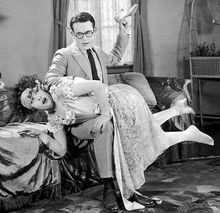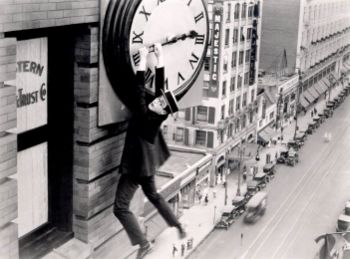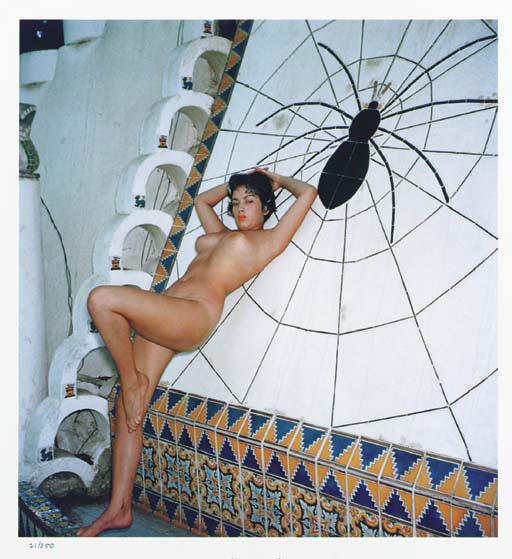Harold Lloyd
- This article is a Biography
Click here for Early Movie History category page |
Click here for Nexus:Spiderpool |
| Harold Lloyd | ||
 Lloyd in 1929 | ||
| Background information | ||
| Born | Apr 20, 1893 | |
| Birth place: | Burchard, Nebraska USA | |
| Born as | Harold Clayton Lloyd | |
| Died | Mar 8, 1971 - age 78 | |
| Beverly Hills, CA USA | ||
| Spouse(s) | Mildred Davis | |
| Notable roles | Safety Last! | |
Harold Clayton Lloyd (✦April 20, 1893 † March 8, 1971) was an American film actor and producer, most famous for his silent film comedies.
Harold Lloyd ranks alongside Charlie Chaplin and Buster Keaton as one of the most popular and influential film comedians of the silent film era. Lloyd made nearly 200 comedy films, both silent and "talkies", between 1914 and 1947. He is best known for his "Glasses Character", a resourceful, success-seeking go-getter who was perfectly in tune with 1920s era America.
His films frequently contained "thrill sequences" of extended chase scenes and daredevil physical feats, for which he is best remembered today. Lloyd hanging from the hands of a clock high above the street in Safety Last! (1923) is one of the most enduring images in all of cinema. Lloyd did many of these dangerous stunts himself, despite having injured himself during the filming of Haunted Spooks (1920) when an accident with a prop bomb resulted in the loss of the thumb and index finger of his right hand (the injury was disguised on film with the use of a special prosthetic glove, though the glove often did not go by unnoticed).
Although Lloyd's individual films were not as commercially successful as Charlie Chaplin's on average, he was far more prolific (releasing twelve feature films in the 1920s while Chaplin released just three), and they made more money overall ($15.7 million to Chaplin's $10.5 million).
Early life and entry into films

Lloyd was born in Burchard, Nebraska to James Darsie Lloyd and Elizabeth Fraser; his paternal great-grandparents were from Wales. [1] Lloyd had moved west with his family after his father failed in numerous business ventures.
He had acted in theater since boyhood and started acting in one-reel film comedies shortly after moving to California in 1912 in San Diego, California. Lloyd soon began working with Thomas Edison's motion picture company and eventually formed a partnership with fellow struggling actor and director Hal Roach, who had formed his own studio in 1913. The hard-working Lloyd became the most successful of Roach's comic actors between 1915 and 1919.
He hired Bebe Daniels as a supporting actress in 1914; the two of them were involved romantically and were known as "The Boy" and "The Girl". In 1919, she left Lloyd because of greater dramatic aspirations. Lloyd replaced Daniels with Mildred Davis in 1919, who the more he watched (from a movie Hal Roach told him to check out) the more he was eager to get her. Lloyd's first reaction in seeing her was that "she looked like a big French doll!"
Lloyd's early film character "Lonesome Luke" was by his own admission a frenetic imitation of Chaplin. By 1918, Lloyd and Roach had developed the "Glasses Character" (always named "Harold" in the films), a much more mature comedy character with greater potential for sympathy and emotional depth. Beginning in 1921, they moved from shorts to feature length comedies. These included the acclaimed Grandma's Boy (1922), which (along with Chaplin's The Kid (1921) pioneered the combination of complex character development and film comedy, the sensational Safety Last! (1923), which cemented Lloyd's stardom, and Why Worry? (1923).
Lloyd and Roach parted ways in 1924, and Lloyd became the independent producer of his own films. These included his most accomplished mature features Girl Shy (1924), The Freshman (1925), The Kid Brother (1927), and Speedy (1928). Welcome Danger (1929) was originally a silent film but Lloyd decided late in the production to remake it with dialogue. All of these films were enormously successful and profitable. They were also highly influential and still find many fans among modern audiences, a testament to the originality and film-making skill of Lloyd and his talented collaborators. Like the other great silent comics, Lloyd was the driving creative force in his films, particularly the feature-length films. From this success he became one of the wealthiest and most influential figures in early Hollywood.
Hand injured in "bomb blast"
On August 24, 1919 Harold was posing for publicity stills at Witzel Photographers, Los Angeles. One shot called for Lloyd to light a cigarette from a prop bomb, striking a sassy, devil-may-care pose. The prop, though, so resembled a real bomb that an actual real bomb got mistakenly mixed in with the fakes – the real bomb was handed to Lloyd. He lit the already-lit cigarette onto the wick, but found that the excessive smoke prohibited a good picture. As he signaled for a new wick, the bomb exploded. The force of the blast temporarily blinded Lloyd, and severed the thumb and forefinger from his right hand, and kept him out of the studio for almost five months. Thanks to the input of former glove salesman Sam Goldwyn, Lloyd's impairment was covered within a prosthetic glove. At no time did Lloyd ever discuss the loss of the fingers – he would acknowledge the accident, but not the disability. Lloyd did not want his audiences to come to see his films out of pity or curiosity. He wanted people, simply, to laugh with him.
'Talkies' and semi-successful transition
In 1924 he formed his own independent film production company, the Harold Lloyd Film Corporation, with his films distributed by Pathé and later Paramount Pictures and Twentieth Century-Fox. Lloyd was a founding member of the Academy of Motion Picture Arts and Sciences ("The Oscars").
Lloyd made the transition to sound in 1929 with Welcome Danger (the original unreleased silent version of this film was screened in various cities on the 2005 re-release of Lloyd's films). Released a few weeks before the start of the Great Depression, it was a huge financial success, with audiences eager to hear Lloyd's voice on film. Lloyd's rate of film releases, which had been one or two a year in the 1920s, slowed to about one every two years until 1938.
The films released during this period were: Feet First (1930), with a similar scenario to Safety Last which found him clinging to a skyscraper at the climax; Movie Crazy (1932) with Constance Cummings; The Cat's-Paw (1934), which was a dark political comedy and a big departure for Lloyd; and The Milky Way (1936), which was Lloyd's only attempt at screwball comedy, at that point hugely fashionable.
To this point the films had been personally produced by Lloyd's own company, Unfortunately, his go-getting screen character was now out of touch with Great Depression movie audiences of the 1930s. As the length of time between his film releases increased, his popularity declined, and so did his production company. His final film of the decade, Professor Beware, was made by the Paramount staff, with Lloyd functioning only as actor and partial financier.
On March 23, 1937, Lloyd sold the land of his studio Harold Lloyd Motion Picture Company to The Church of Jesus Christ of Latter-Day Saints. The location is now the site of the Los Angeles California Temple.
Lloyd produced a few comedies for RKO Radio Pictures in the early 1940s but otherwise retired from the screen until 1947. He returned for an additional starring appearance in The Sin of Harold Diddlebock (1947), an ill-fated homage to Lloyd's career directed by Preston Sturges and financed by Howard Hughes. The idea was to show what happened to Harold's optimistic character from The Freshman in later life. Diddlebock actually opened with footage from The Freshman, and Lloyd was sufficiently youthful-looking to match the older scenes quite well. Lloyd and Sturges had different conceptions of the material, however, and fought frequently during the shoot. The finished film was released briefly in 1947, then shelved by producer Hughes. Hughes recut the film and reissued in 1950 under the title Mad Wednesday. It was a sad end to a brilliant film career.
Marriage and home
Lloyd married his leading lady, Mildred Davis, on Saturday February 10, 1923. Together, they had two children: Gloria Lloyd (born 1923), and Harold Lloyd, Jr., (1931-1971). They also adopted Peggy (1924-1986) in 1930. Lloyd, for a time, discouraged Davis from continuing her acting career. He later relented, but by that time her career momentum was lost. Mildred died in 1969, two years before Lloyd's death.
Lloyd's Beverly Hills home, "Greenacres" was built in 1926-1929, with 44 rooms, 26 bathrooms, 12 fountains, 12 gardens, and a nine-hole golf course. The estate left the possession of the Lloyd family in 1975, after a failed attempt to maintain it as a public museum.
The grounds were subsequently subdivided, but the main house remains and is frequently used as a filming location, appearing in films like Westworld and The Loved One. It is listed on the National Register of Historic Places.
Radio and retirement
In October 1944, he emerged as the director and host of The Old Gold Comedy Theater, an National Broadcasting Company (NBC) radio anthology series, when Preston Sturges turned the job down but recommended him for it. The show presented half-hour radio adaptations of recently successful film comedies, launching with a version of Palm Beach Story with Claudette Colbert and Robert Young.
Some saw The Old Gold Comedy Theater as being a lighter version of Lux Radio Theater, and it featured some of the best-known film and radio personalities of the day, including Fred Allen, June Allyson, Lucille Ball, Ralph Bellamy, Linda Darnell, Susan Hayward, Herbert Marshall, Dick Powell, Edward G. Robinson, Jane Wyman, and Alan Young, among others. But the show's half-hour format — which meant the material might have been truncated too severely — and Lloyd's sounding somewhat ill at ease on the air for much of the season (though he spent weeks training himself to speak on the radio prior to the show's premiere, and seemed more relaxed toward the end of the series run) may have worked against it.
The Old Gold Comedy Theater ended in June 1945 with an adaptation of Tom, Dick, and Harry, featuring June Allyson and Reginald Gardiner, and was not renewed for the following season. Many years later, acetate discs of 29 of the shows were discovered in Lloyd's home, and they now circulate among old-time radio collectors.
Lloyd remained involved in a number of other interests, including civic and charity work. Inspired by having overcome his own serious injuries and burns, he was very active with the Shriners Hospital for Crippled Children and eventually rose to that organization's highest office, Imperial Potentate.
He appeared as himself on several television shows during his retirement, first on Ed Sullivan's variety show "Toast of the Town" on June 5, 1949, and again on July 6, 1958. He appeared as the Mystery Guest on What's My Line? in April 26, 1953, and twice on This Is Your Life on March 10, 1954, for Mack Sennett, and again on December 14, 1955, on his own episode.
Lloyd studied colors, microscopy, and was very involved with photography, including 3D photography and color film experiments. Some of the earliest 2-color Technicolor tests were shot at his Beverly Hills home. He became known for his nude photographs of models, such as Bettie Page and stripper Dixie Evans, for a number of men's magazines. He also took photos of Marilyn Monroe lounging at his pool in a bathing suit which were published after their deaths. In 2004, his granddaughter Suzanne produced a book of selections from his photographs, Harold Lloyd's Hollywood Nudes in 3D! (isbn 1-57912-394-5).
Lloyd also provided encouragement and support for a number of younger actors, including Jack Lemmon, Debbie Reynolds and Robert Wagner.
Renewed interest
Lloyd kept copyright control of most of his films and re-released them infrequently after his retirement. As a consequence, his reputation and public recognition suffered in comparison with Chaplin and Keaton, whose work has generally been more available.
Also, Lloyd's film character was so intimately associated with the 1920s era that attempts at revivals in the 1940s and 1950s were poorly received when audiences viewed the 1920s (and silent film in particular) as old-fashioned. In the early 1960s, Lloyd produced two compilation films, featuring scenes from his old comedies, Harold Lloyd's World of Comedy (1962) and The Funny Side of Life (1963).
These films were positively received and renewed interest in Lloyd, helping to restore Lloyd's status among film historians. Throughout his later years, he screened his films for audiences at special charity and educational events, to great acclaim.
Following his death, most of his feature films were marketed by Time-Life Films and shown frequently on television, but these were poorly presented, with intrusive narration and insensitive musical scores. Through the efforts of Kevin Brownlow and David Gill and the support of granddaughter Suzanne Lloyd Hayes, the British Thames Television Silents series re-released some of the feature films in the early 1990s on video (with new orchestral scores by Carl Davis).
More recently, the remainder of Lloyd's great silent features and many shorts were fully restored, with new orchestral scores by Robert Israel. These are now frequently shown on the Turner Classic Movies (TCM) cable channel. An acclaimed 1990 documentary by Brownlow and Gill also created a renewed interest in Lloyd's work in the early 1990s. A DVD Collection of restored versions of most of his feature films (and his more important shorts) was released by New Line Cinema in partnership with the Harold Lloyd Trust in November 2005, along with limited theatrical screenings in New York City and other cities in the US, Canada and Europe. Annette Lloyd has also said that if there is a large enough show of support by fans, a second collection may be released in the future
Academy Award
In 1952, Lloyd received a special Academy Award for being a "master comedian and good citizen." The second citation was a snub to Chaplin, who at that point had fallen foul of McCarthyism and who had had his entry visa to the United States revoked. Regardless of political aspects, Lloyd accepted the award in good part.
Death
Lloyd died at age 77 from prostate cancer on March 8, 1971, in Beverly Hills, California. He was interred in a crypt in the Great Mausoleum at Forest Lawn Memorial Park Cemetery in Glendale, California.
Walk of Fame
Harold Lloyd has two stars on the Hollywood Walk of Fame. His was only the fourth ceremony preserving his handprints, footprints, autograph, and outline of his famed glasses, at Grauman's Chinese Theatre, in 1927. In 1994, he was honored with his image on a United States postage stamp designed by caricaturist Al Hirschfeld.
Tributes and references to Lloyd
- The 2001 Futurama episode "That's Lobstertainment!" was a tribute to Harold Lloyd, featuring an alien version of him, named Harold Zoid.
- In the opening scene of Back to the Future, amongst the plethora of clocks in "Doc" Brown's house, one featuring the tiny figure of Lloyd hanging from the hands can be seen.
- Lloyd is mentioned in the 2004 movie I, Robot.
- Harold Lloyd is mentioned in the movie "The Last Emperor".
Filmography
Harold Lloyd at the Internet Movie Database
Autobiography and notable biographies
- Lloyd, Harold (1928, revised 1971). An American Comedy.
- Schickel, Richard (1974). Harold Lloyd: the shape of laughter. New York Graphic Society. isbn 0-8212-0595-1.
- McCaffrey, Donald W. (1976). Three Classic Silent Screen Comedies Starring Harold Lloyd. Associated University Presses. isbn 0-8386-1455-8.
- Reilly, Adam (1977). Harold Lloyd: The king of daredevil comedy. Macmillan. isbn 0-02-601940-X.
- Dardis, Tom (1983). Harold Lloyd: The Man on the Clock. Viking. isbn 0-14-007555-0.
- Vance, Jeffrey, and Suzanne Lloyd (2002). Harold Lloyd: Master Comedian. Harry N Abrams. isbn 0-8109-1674-6.
- D'Agostino Lloyd, Annette M. (2003). The Harold Lloyd Encyclopedia. McFarland & Company. isbn 0-7864-1514-2.
See also
- List of United States comedy films
References
External links
- Harold Lloyd at the Internet Movie Database
- http://www.haroldlloyd.com - the official site of Harold Lloyd
- HaroldLloyd.us — a site with articles and information, maintained by Annette Lloyd
- Harold Lloyd Forum part of ComedyClassics.org
- Harold Lloyd Photos at Silent Ladies & Gents
- BBC Radio Interview with Suzanne Lloyd (2002)
- Harold Lloyd in The Sin Of Harold Diddlebock at The Internet Archive
A Personal Note from Robin
The picture below is of Tura Satana. It was taken by Harold Lloyd (at the Spiderpool, part of the John McDermott estate) and is printed as a 3-D photo on p.100 of Harold Lloyd's Hollywood Nudes in 3-D < ISBN:1579126790 Buy it from Amazon.com >
(This book is part of "The BackDrop Club Research Library)")
See also Harold Meadows and/or John_Willie_and_The_Spiderpool
What links here • References and Sources • Help • Contact info
